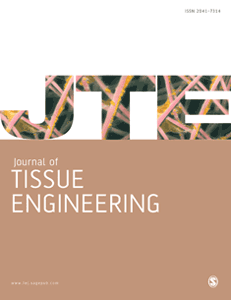Mesenchymal stem cells overexpressing XIST induce macrophage M2 polarization and improve neural stem cell homeostatic microenvironment, alleviating spinal cord injury
IF 7
1区 工程技术
Q1 CELL & TISSUE ENGINEERING
引用次数: 0
Abstract
Spinal cord injury (SCI) is a significant cause of disability worldwide, with limited treatment options. This study investigated the potential of bone marrow-derived mesenchymal stem cells (BMSCs) modified with XIST lentiviral vector to modulate macrophage polarization and affect neural stem cell (NSC) microenvironment reconstruction following SCI. Bioinformatics analysis revealed that MID1 might be crucial for BMSCs’ treatment of SCI. XIST overexpression enriched Zmynd8 to the promoter region of MID1 and inhibited MID1 transcription, which promoted macrophage M2 polarization. In vitro experiments showed that BMSCs-XIST promoted NSC proliferation, migration, differentiation, and axonal growth by inducing macrophage M2 polarization, suppressing inflammation, and accelerating the re-establishment of the homeostatic microenvironment of NSCs. In vivo, animal experiments confirmed that BMSCs-XIST significantly alleviated SCI by promoting NSC differentiation and axon formation in the injured area. The study demonstrated the potential of XIST-overexpressing BMSCs for treating SCI by regulating macrophage polarization and homeostasis of the NSC microenvironment. These findings provide new insights into the development of stem cell-based therapies for SCI.过表达 XIST 的间充质干细胞可诱导巨噬细胞 M2 极化,改善神经干细胞稳态微环境,从而缓解脊髓损伤
脊髓损伤(SCI)是全球致残的一个重要原因,但治疗方案有限。本研究调查了经XIST慢病毒载体修饰的骨髓间充质干细胞(BMSCs)调节巨噬细胞极化和影响脊髓损伤后神经干细胞(NSC)微环境重建的潜力。生物信息学分析表明,MID1可能是BMSCs治疗SCI的关键。XIST的过表达使Zmynd8富集到MID1的启动子区域,抑制了MID1的转录,从而促进了巨噬细胞M2的极化。体外实验表明,BMSCs-XIST 通过诱导巨噬细胞 M2 极化、抑制炎症和加速重建 NSCs 的稳态微环境,促进了 NSC 的增殖、迁移、分化和轴突生长。体内动物实验证实,BMSCs-XIST 通过促进损伤区域的 NSC 分化和轴突形成,显著缓解了 SCI。该研究证明,通过调节巨噬细胞的极化和NSC微环境的平衡,XIST表达的BMSCs具有治疗SCI的潜力。这些发现为开发基于干细胞的SCI疗法提供了新的见解。
本文章由计算机程序翻译,如有差异,请以英文原文为准。
求助全文
约1分钟内获得全文
求助全文
来源期刊

Journal of Tissue Engineering
Engineering-Biomedical Engineering
CiteScore
11.60
自引率
4.90%
发文量
52
审稿时长
12 weeks
期刊介绍:
The Journal of Tissue Engineering (JTE) is a peer-reviewed, open-access journal dedicated to scientific research in the field of tissue engineering and its clinical applications. Our journal encompasses a wide range of interests, from the fundamental aspects of stem cells and progenitor cells, including their expansion to viable numbers, to an in-depth understanding of their differentiation processes. Join us in exploring the latest advancements in tissue engineering and its clinical translation.
 求助内容:
求助内容: 应助结果提醒方式:
应助结果提醒方式:


